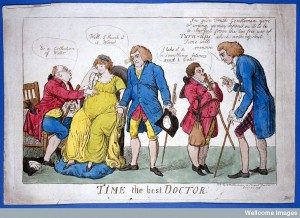By Lisa Smith, W&M Contributor

A group of physicians wrongly diagnosing the case of a pregnant woman. Coloured etching by I. Cruikshank, 1803. Image Credit: Wellcome Library, London.
I was rustling through some old research notes on strange pregnancies when a detail in a case addressed to the Société Royale de Médecine from 1787 suddenly caught my eye. The case was one of unexpected pregnancy in which an unnamed forty-four year old woman (sterile for twenty-three years, one month and sixteen days of marriage) at long last gave birth.
Although I’ve looked at the case in terms of the experience of sterility, medical decision-making and community interest, I hadn’t paid much attention to the woman’s fears of a false pregnancy and her attempts to understand her symptoms.
Throughout her pregnancy, the woman had exhibited all the normal symptoms, but rather than celebrate, “she tormented herself with the fears” of false pregnancy, which seemed more likely given her history.
Having truly desired to have a child for so many years she had not dared to flatter herself with a true pregnancy and also feared the mockery.
She consulted with several local “people of the art [of medicine]”, who prescribed treatments to expel a false conception. Although her husband also believed that her symptoms were caused by a Mole (fleshy uterine growth), he asked Dr. Moulet of Caussade, Mantauban for advice. Moulet concluded that the woman was, indeed, pregnant.
This gave the couple hope, although they did not fully believe Moulet’s diagnosis. They prepared for childbirth, but in secret with the assistance of an accoucheur (man-midwife) from outside the community rather than a local midwife. If the the pregnancy proved false, the accoucheur (i.e. a man and one who was not local) would be less likely to gossip. At the centre of Moulet’s diagnosis was the issue of fetal movement. Moulet insisted that the movements in the woman’s belly indicated that she was definitively pregnant. But the woman was unconvinced—“one of her friends had informed [her] of such movement in a false pregnancy.”
This was when I did a double-take: do women with false pregnancies experience such movements? Or was this just a story about pregnancy that, as Moulet put it, served to “spread much timidity and alarm among the women”? I consulted Dr. Google and ended up down a very dark path of pseudocyesis: apparently the sensation of fetal movement in false pregnancies is very common!
I turned to well-known accoucheurs Mauriceau (The Diseases of Women with Child, and in Child-Bed, 1755 edition) and Dionis (A General Treatise of Midwifery, 1719 edition) to see what advice they offered. Mauriceau defined a false pregnancy as one
in which, instead of a Child, is ingendered nothing but Strange Matter, as Wind mixed with Waters, which are called Dropsies of the Womb, false conceptions, Moles, or Membranes full of Blood and corrupted Seed.
The cause of false conceptions, according to Mauriceau, was having too much sex. Dionis, however, believed that the cause came from either the male’s seed being too “effete” to fecundate the egg or the woman’s egg being too tough for the seed.
The symptoms of true and false pregnancies were, indeed, difficult to distinguish (whatever Moulet’s confidence). According to Mauriceau, women often believed they were pregnant if their courses stopped and they felt a bit “qualmish”, but this was an error—”for false Conceptions cause almost the same Accidents as true; and cannot easily be distinguished but by the Consequences.”
Whereas Moulet insisted that the baby’s movement was definitive, Mauriceau cautioned: “Be careful not to be deceived by what we feel stir in the Womb, forasmuch as the Infant of it self hath a total [full body] and a partial [only limbs] Motion.” What made it most confusing that was “fits of the Mother and Moles have by accident a total kind of Motion, but never partial.” For example, a Mole always fell heavily onto whichever side a woman was lying on. The only way to know for sure was by physicially examining the woman to see whether the cervix was closed and the womb distended.
In addition, Dionis believed that the woman’s age was important; women “are most subject to these false Big Bellies from the thirty fifth to the fortieth Year of their Age.” At this age, women had less regular courses and the build up of too much blood or the badness of retained blood would easily lead to imperfect conceptions.
Given her age and the ambiguity of pregnancy symptoms, no wonder Moulet’s patient remained uncertain of her pregnancy until the end!
